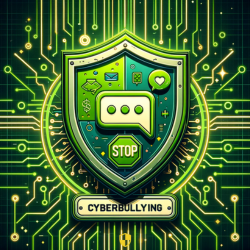Cyberbullying is a modern form of bullying that happens online. It’s when someone uses the internet, emails, texts, or social media to harass, threaten, embarrass, or target another person. Unlike traditional bullying, cyberbullying doesn’t require physical strength or face-to-face contact and can happen at any time, making it hard for victims to escape.
The Many Faces of Online Bullying
Online bullying can take many forms. It might be mean messages or threats sent directly to the person. It could also be hurtful comments posted about them on social media or shared with a group. Sometimes, it involves sharing someone’s personal or embarrassing information or photos without their permission. Each of these acts can hurt a person’s feelings and make them feel unsafe or alone.
How Cyberbullying Affects Us
The effects of cyberbullying are serious. It can make the person being bullied feel scared, stressed, embarrassed, or alone. It can affect their self-esteem and mental health. In extreme cases, it can lead to self-harm or even suicide. It’s not just a problem for young people – it can affect adults too. It’s important to recognize cyberbullying and take steps to stop it, to help keep everyone safe online.
Spotting Cyberbullying
Identifying cyberbullying early is key to preventing its harmful effects. Cyberbullying can be more insidious than traditional bullying because it occurs in the digital realm, where it’s easier to miss. By being aware of the signs, both on and offline, parents, teachers, and peers can intervene and offer support.

Changes That Suggest Cyberbullying
Cyberbullying can manifest in various behavioral changes. These may include:
- Emotional Shifts: Sudden mood swings, increased irritability, or unexplained sadness, especially after using digital devices.
- Avoidance Behavior: A noticeable reluctance or fear towards using computers, smartphones, or participating in online activities where they were once active.
- Social Withdrawal: A decline in interacting with friends or family, and a loss of interest in activities that were previously enjoyed.
- Performance Impact: Drops in academic performance or a lack of concentration that seems linked to their digital interactions.
These signs indicate that a person might be struggling with online harassment, necessitating a supportive response.
Online Signs of Bullying
Cyberbullying leaves traces in the digital environment. Keep an eye out for:
- Message Patterns: An unusual increase or decrease in the number of texts, emails, or social media messages.
- Account Changes: Deactivating social media accounts unexpectedly, or the creation of new ones, possibly to escape bullying or harassment.
- Public Hostility: Visible hurtful, threatening, or embarrassing posts, comments, or images directed at the individual on social media platforms.
- Exclusion: Being deliberately left out of online groups, chats, or activities, which can be a form of social bullying.
Recognizing these online signs is critical for timely intervention to prevent further harm and to support the victim. It’s important to encourage open communication about online experiences and to monitor online activities for potential red flags. Providing a safe and understanding environment for discussion can make it easier for those experiencing cyberbullying to speak up and seek help.
Creating a Safe Online Space
Creating a safe and secure online environment is key to protecting against cyberbullying. This involves setting clear, understandable rules for internet use and making sure all online accounts are safe and secure.
Rules for Internet Use
Good rules for using the internet can greatly lower the risk of someone being bullied online. Consider these guidelines:
1. Specific Time Limits:
- Set exact times for when the internet can be used. For example, no internet after dinner or only an hour of social media per day.
- Explain why these limits are important – too much screen time can affect sleep and mental health.
- Use parental controls if necessary to help enforce these times.
2. Use Devices in Common Areas:
- Encourage the family to use phones and computers in shared spaces like the living room. This makes it easier to monitor online activities without being too intrusive.
- Explain that this helps keep everyone safe and is not about mistrust. It’s about being part of a family where everyone looks out for each other.
3. Talk About Online Safety:
- Have open and regular discussions about the risks of the internet. Talk about respecting others online, what cyberbullying is, and why it’s harmful.
- Use real-life examples and news stories to make the dangers more relatable.
- Encourage them to come to you if they encounter anything uncomfortable online.
4. Keep an Eye on Usage:
- Occasionally check what sites and apps are being used, making sure they are age-appropriate and safe.
- Teach them how to use privacy settings and why they are important.
- Let them know you’re doing this to protect them, not to invade their privacy.
By following these guidelines, you can create a safer and more controlled online environment for your family. It’s all about balancing safety with respect for their privacy and independence.
Keeping Online Accounts Secure
Making sure online accounts are secure is important in preventing cyberbullying:
- Use Strong Passwords: Choose passwords that are hard to guess. Change them often and don’t share them, even with close friends.
- Check Privacy Settings: Regularly look at and update privacy settings on social media to control who sees and interacts with your information.
- Watch for Unusual Activity: Keep an eye on your accounts. Strange messages or posts might mean your account has been hacked.
- Learn About Online Scams: Know about the risks of clicking on strange links and sharing personal information. Teach others about these dangers too.
By taking these steps, personal information stays safe and the chances of being bullied online through hacked accounts are lowered.
How to Respond to Cyberbullying
Dealing with cyberbullying involves a careful and supportive approach. It’s important to know the right steps to take in order to effectively stop the bullying and provide help to the victim.

First Steps When Facing Online Bullying
If you or someone you know is experiencing cyberbullying, it’s vital to handle the situation with care:
- Stay Calm and Composed: Avoid reacting impulsively. A calm approach is more effective and helps in thinking clearly about the next steps.
- Do Not Engage: Responding or trying to retaliate can escalate the situation. It’s best to avoid giving the bully the reaction they’re seeking.
- Preserve the Evidence: Save all messages, posts, comments, or any form of bullying evidence. This could be important for reporting the bullying later.
- Seek Trusted Support: Reach out to someone you trust for support and advice, such as a family member, teacher, or close friend. Sharing the problem can make it easier to deal with.
Taking these initial steps can help in managing the situation calmly and effectively.
Keeping Records and Reporting Bullying
Documenting and reporting the cyberbullying incident are crucial for addressing it appropriately:
- Document All Instances: Keep a record of every instance of bullying. Take screenshots and save emails or text messages. Make sure to note the dates and times of each incident.
- Inform the Relevant Authorities: Depending on the situation, inform parents, school officials, or the administrators of the platform where the bullying occurred. Most social media platforms have a way to report abusive behavior.
- Consider Formal Reporting: In cases where there is a threat of harm, or if the bullying is particularly severe, it might be necessary to report it to law enforcement or other legal authorities.
By documenting and reporting the bullying, you are taking critical steps to not only stop the bullying but also to protect yourself or the person being bullied. It’s important to understand that taking action can prevent further harm and bring the situation under control.
Helping and Getting Help
Offering support and knowing where to seek help are critical in dealing with cyberbullying. It’s about understanding how to be there for someone in need and where to turn for additional assistance.
How to Support Someone Being Bullied Online
When someone is facing cyberbullying, your support can make a significant difference:
- Listen and Validate Their Feelings: Let them talk about their experience and feelings. Show understanding and empathy.
- Offer Reassurance: Assure them that it’s not their fault and that they’re not alone.
- Advise on Steps: Suggest saving evidence and not responding to the bully. Guide them on reporting the bullying if needed.
- Stay Connected: Check in with them regularly. Ongoing support is crucial for their emotional well-being.
Being a supportive ally can help the victim feel less isolated and more empowered to deal with the situation.
Where to Find Help
Knowing where to find help is crucial in tackling cyberbullying:
- School Resources: If the bullying involves schoolmates, reach out to teachers or school counselors.
- Online Support: Many social media platforms have resources and reporting mechanisms for bullying.
- Professional Assistance: In severe cases, seeking help from mental health professionals or legal advice can be beneficial.
- Community Groups: Local community centers or online support groups can offer advice and support.
Having these resources at hand ensures that the right help can be accessed when needed, providing a pathway to resolve the situation and heal.
Teaching Kids About Online Respect
Educating kids about respecting others online is a key step in preventing cyberbullying. This includes guiding them in their online interactions and equipping them with strategies to handle bullying if it occurs.
Guiding Children in Online Interactions
When teaching children how to interact online, emphasize these points:
- Empathy and Kindness: Encourage them to treat others as they would like to be treated.
- Think Before Posting: Remind them to consider the impact of their words and actions online.
- Respecting Privacy: Teach them the importance of not sharing personal information about themselves or others.
- Recognizing Inappropriate Behavior: Help them understand what is not acceptable online, such as rude comments or sharing hurtful content.
Guiding children in these areas helps foster a safe and respectful online environment.
Kids’ Strategies Against Cyberbullying
Equip kids with strategies to protect themselves against cyberbullying:
- Speak Up: Encourage them to talk to an adult if they or someone they know is being bullied.
- Don’t Engage: Teach them not to respond to bullying messages, as this can escalate the situation.
- Use Privacy Settings and Reporting Tools: Show them how to use privacy settings on social media and how to report inappropriate content or behavior.
- Be a Positive Influence: Encourage them to be a positive presence online, supporting friends and speaking out against bullying.
Empowering kids with these strategies gives them the tools to navigate online spaces safely and respectfully.
Stopping Bullying Before It Starts
Preventing bullying begins with proactive steps from parents, teachers, and within community activities. By fostering awareness and understanding, we can create environments where bullying is less likely to occur.
Roles of Parents and Teachers
Parents and teachers play a pivotal role in preventing bullying:
- Open Communication: Encourage open discussions about bullying, including what it looks like and how to respond.
- Modeling Behavior: Demonstrate respectful and kind behavior in interactions with others.
- Setting Clear Expectations: Make it clear that bullying is unacceptable and outline the consequences for such behavior.
- Educational Programs: Implement programs or sessions in schools that specifically address bullying, its impacts, and prevention strategies.
Engaging parents and teachers in these efforts creates a strong foundation for a bully-free environment.
Bringing Awareness into Activities
Integrating anti-bullying awareness into various activities can further reinforce the message:
- Incorporate in Curriculums: Include lessons on empathy, digital citizenship, and conflict resolution in the regular curriculum.
- After-School Programs: Offer activities that promote teamwork and respect among students.
- Community Events: Host workshops or seminars for parents and children that focus on bullying prevention and building positive community relationships.
- Peer Leadership: Encourage older students to act as role models and leaders in anti-bullying initiatives.
By integrating awareness into everyday activities, children and adolescents learn to recognize and stand up against bullying in all its forms.
Conclusion
In the journey to combat cyberbullying, knowledge and action are our strongest allies. From understanding what cyberbullying is to recognizing its signs, we’ve covered the essential steps to create a safer online environment for everyone. Parents, teachers, and peers have pivotal roles in educating and guiding children about respectful online behavior and providing support when needed. Remember, stopping cyberbullying begins with each of us being aware, proactive, and supportive. By implementing the strategies discussed, we can work towards an internet that’s safer and more positive for all users. Let’s all commit to taking a stand against cyberbullying, promoting kindness and respect in every interaction, whether online or offline. Together, we can make a significant difference in the digital world, ensuring it’s a place of connection and support, not fear and harm.








